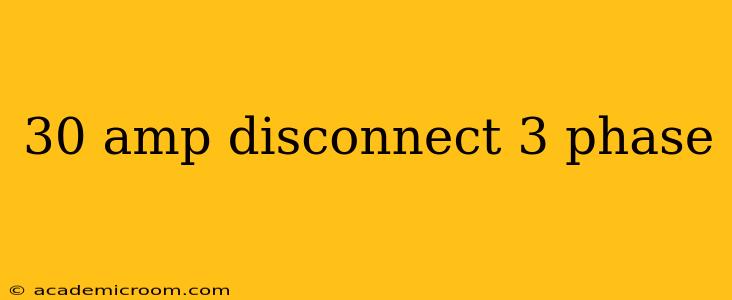Finding the right disconnect switch for your three-phase electrical system can be challenging. This guide will delve into the specifics of 30-amp, three-phase disconnect switches, clarifying their applications, safety features, and selection criteria. We'll also address common questions surrounding these crucial components of electrical infrastructure.
What is a 30 Amp 3-Phase Disconnect?
A 30-amp, three-phase disconnect switch is a safety device used to isolate sections of a three-phase electrical circuit. It allows you to manually disconnect power, preventing electrical shock and facilitating maintenance or repairs. Unlike circuit breakers, which automatically trip in case of overcurrent, disconnect switches are manually operated. They are crucial for safety and are often required by electrical codes for various applications. The "30-amp" rating refers to the maximum current the switch can safely handle continuously. "Three-phase" indicates its compatibility with electrical systems using three-phase power, common in industrial and commercial settings.
What are 30 Amp 3-Phase Disconnects Used For?
These disconnects find application in a variety of settings where three-phase power is employed:
- Industrial Machinery: Powering large motors, pumps, and other equipment requiring substantial amperage.
- Commercial Buildings: Supplying power to HVAC systems, lighting circuits, and other high-power appliances.
- Agricultural Operations: Used in powering irrigation systems, grain dryers, and other farm equipment.
- Manufacturing Plants: Part of the overall electrical distribution system to isolate sections of the plant.
How to Choose the Right 30 Amp 3-Phase Disconnect?
Selecting the appropriate disconnect switch involves considering several key factors:
- Amperage Rating: Ensure the switch's rating is equal to or greater than the maximum current draw of the circuit it will protect. A 30-amp switch is suitable for circuits that don't exceed this amperage.
- Voltage Rating: The switch must be compatible with the voltage of your system (e.g., 208V, 240V, 480V). Mismatch can lead to dangerous consequences.
- Enclosure Type: Consider the environment where the switch will be installed – indoor, outdoor, NEMA rated for specific environmental conditions (e.g., NEMA 3R for rain-tight outdoor use).
- Mounting Type: Choose between surface mount or flush mount depending on your installation requirements.
- Safety Features: Look for features like visible disconnect indication, padlockable handles to prevent accidental re-energizing during maintenance, and clear labeling.
What are the Different Types of 30 Amp 3-Phase Disconnects?
Several types exist, differentiated by their design and functionality:
- Safety Switches: These combine a disconnect switch with overcurrent protection (fuses or circuit breakers).
- Manually Operated Switches: These require manual operation to turn power on and off.
- Non-fused Switches: These only provide isolation and don't include overcurrent protection; fuses or circuit breakers are required separately in the upstream circuit.
What Safety Precautions Should I Take When Using a 30 Amp 3-Phase Disconnect?
Always prioritize safety:
- Lockout/Tagout Procedures: Implement lockout/tagout procedures before working on any electrical equipment to prevent accidental energization.
- Proper Training: Ensure that only qualified electricians work on or near these devices.
- Inspect Regularly: Regular inspection can help prevent failures and ensure the continued safety of your electrical system.
- Follow Electrical Codes: Always comply with local and national electrical codes.
What is the Difference Between a Disconnect Switch and a Circuit Breaker?
A disconnect switch is primarily for isolating a circuit; it does not provide overcurrent protection. A circuit breaker, on the other hand, both isolates the circuit and protects it from overcurrent conditions by automatically tripping when an overload or short circuit is detected. Often, both are used together in a system for complete protection.
How Do I Wire a 30 Amp 3-Phase Disconnect?
Wiring a three-phase disconnect requires expertise in electrical wiring and knowledge of electrical safety procedures. Improper wiring can lead to electrical hazards. Refer to the manufacturer's instructions and consult a qualified electrician for proper installation. This is crucial to avoid risks and ensure the safe and correct operation of the equipment.
This guide offers a comprehensive overview of 30-amp, three-phase disconnect switches. Remember, always prioritize safety and consult qualified electricians for installation and maintenance.
